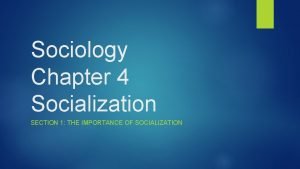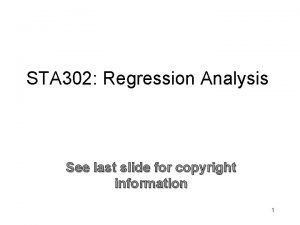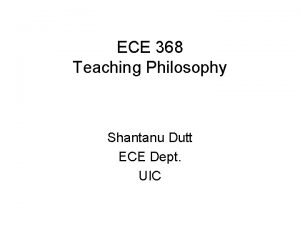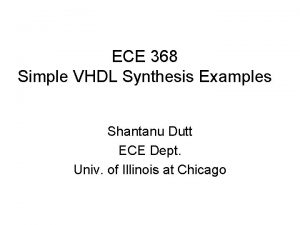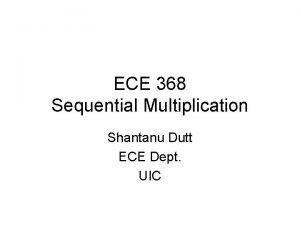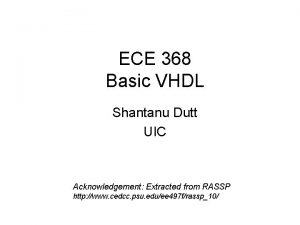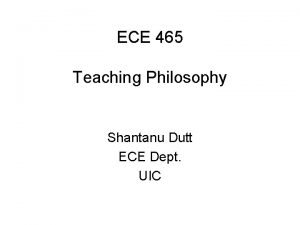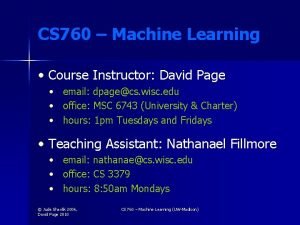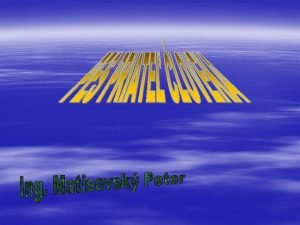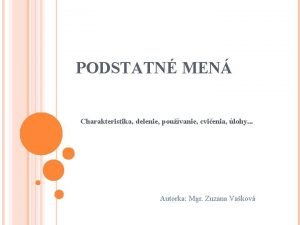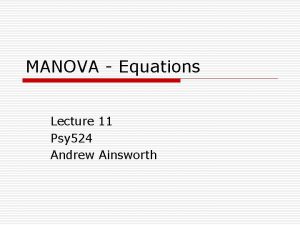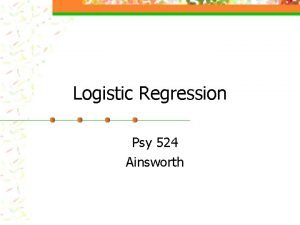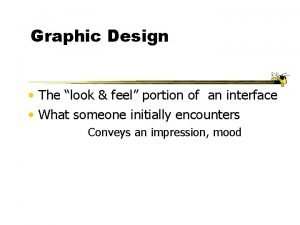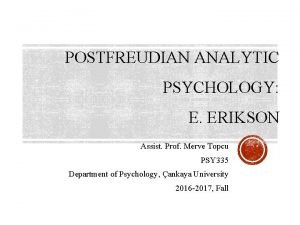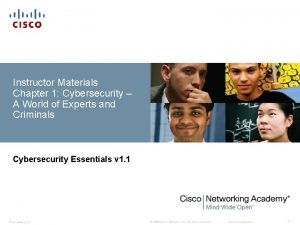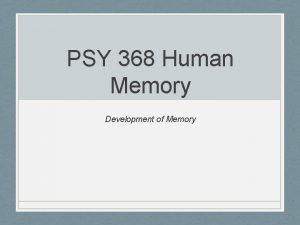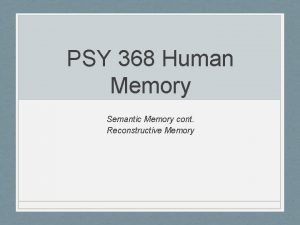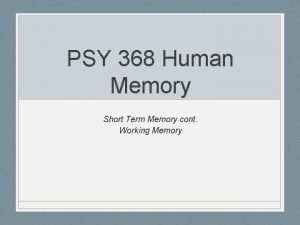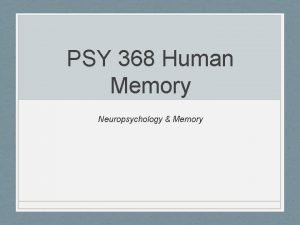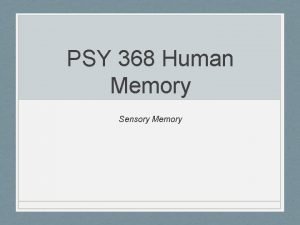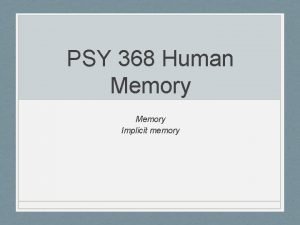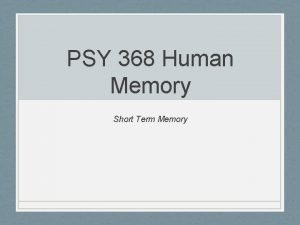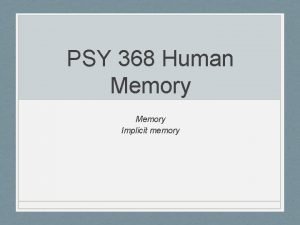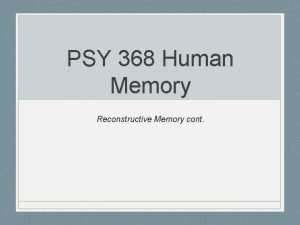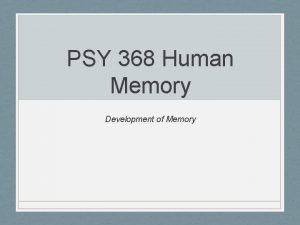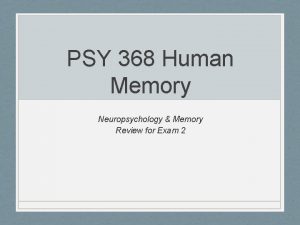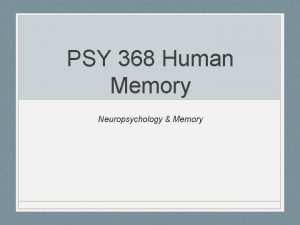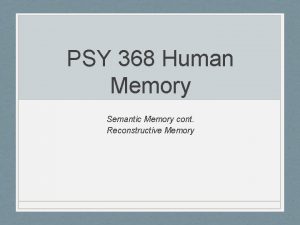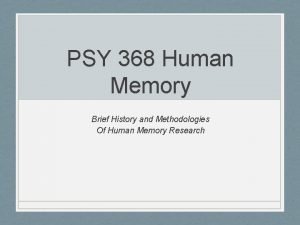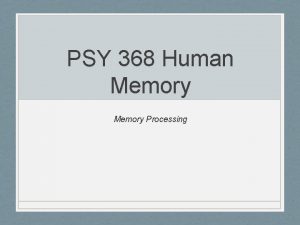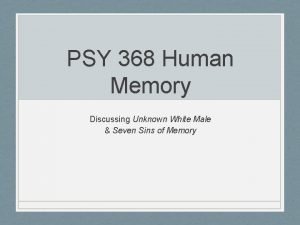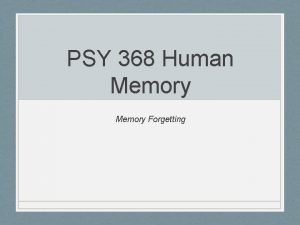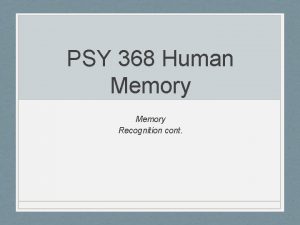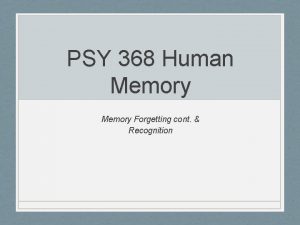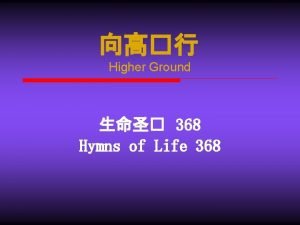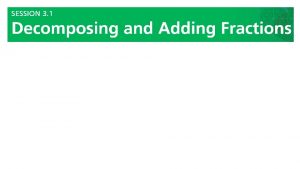PSY 368 Human Memory Experts and Ways to









































- Slides: 41

PSY 368 Human Memory Experts and Ways to improve your memory

Brief outline for today • Cases of superior memory • Flashbulb memories • Eidetic imagery • Memory Experts • Ways to improve you memory • Distributed practice • Testing effects • Mnemonic techniques

Superior Memory • Flashbulb memories • Very vivid memories • Surprising and consequential events – emotionally charged • Difficult to study • Neisser and Harsch (1992) study • Challenger explosion in 1986 - asked people day later about where they were, etc. • After 3 years they were asked to recall details • Reported vivid memories, and were very confident • However, they were inaccurate at remembering these things • No evidence they are different from normal memories • Subject to reconstructive processes (including distortions)

Superior Memory • Eidetic imagery = “Photographic memory” • Strict criteria for classification • Example test procedure (e. g. , Haber & Haber 1964) • Present an image for 30 sec • Remove the image • Ask a variety of questions about details of the image • Answers typically in the present tense (as if the picture is present) • Eyes move to locations where the details had been in picture • Frequency of occurrence • Mostly in preadolescent children (estimated 8% of kids) • Rare in adults - not well-studied

Superior Memory • Eidetic imagery = “Photographic memory” • Not like a photograph, rather it is a strong, vivid image • Eidetic images have more detail than normal images and last longer than iconic memory. • But they do fade away (between a few seconds and a few minutes), they are not long lasting (so don’t seem to be encoded with high detail in LTM) • Requires time to encode (not like the split second camera snapshot) • Affected by the subjective state of the individual and may include distortions, additions, and/or omissions

Memory Experts • Luria (1968), The Mind of a Mnemonist • ‘S’ (Solomon Shereshevsky, Russian journalist & mnemonist) • Average IQ • Memory feats • • Could recall speeches verbatim Memorize complex mathematical equations and matrices Memorize text and poems, even in foreign language Digits (100+) Nonsense syllables Foreign-language poetry Complex figures • Diagnosed as having severe Synesthesia

Memory Experts • Luria (1968), The Mind of a Mnemonist • Synesthesia is a condition where sensations usually experienced in a single modality are experienced in two modalities. • Some examples of synesthesia are receiving an auditory signal or sensation in a visual modality. • Synesthesia is rule governed, not random. • For example, there is a positive relationship between increasing the pitch of a sound and increased brightness. • For S, musical tones were colors, touch were tastes • Thinking about numbers: • “take the number 1. This is a proud, well-built man; 2 is a high-spirited woman; 3 a gloomy person; 6 a man with a swollen foot; 7 a man with a moustache; 8 a very stout woman—a sack within a sack. As for the number 87, what I see is a fat woman and a man twirling his moustache”

Memory Experts • Ericsson and Chase (1982) • They had a university student (SF) practice the digit span task for 1 hour per day for 2 years • Over this time, his span increased from about 7 items to 80 items • Encoding and retrieval principles in action: • He increased his span to 18 items by relating numbers to known running times (e. g. 3594 = “Bannister’s time for the mile”) • He further increased his span by organizing those chunks into a hierarchical structure • Speed-up principle in action: • He became much faster at chunking and organizing the numbers with extensive practice • However, his newfound ability did NOT generalize to other memory tasks • He maintained average letter and word spans

Memory Experts • Thompson et al. (1991) • Rajan Mahadevan: Previously held the world record for memorizing the most digits of pi (30, 000) (note: new record Akira Haraguchi 83, 431 digits) • Found that he had an unusual digit span: • 59 visually presented digits • 63 for heard digits • He chunked digits into strings of 10– 15 digits, not the typical 3– 4 • This initially suggested a natural enhancement of his basic memory capacity • However, arguing against a natural superiority, he has an average: • Symbol span • Ability to remember the position and orientation of various objects • Memory for word lists and stories • It turns out that he uses various associations and patterns to group digits.

Memory Experts • “National Memory Championship” – “Memoriad” • http: //usamemorychampionship. com/ • http: //www. worldmemorychampionships. com/ • http: //www. youtube. com/watch? v=6 vs. YCSm. Bc. M 0&feature=related • Sampling of events (from US & international) • Names and faces (164, 15 • Max deck cards (28 decks, • Speed numbers (500, 5 mins) • Speed cards (1 deck, 21. 2 • Random digits (2080, 1 hr) • Historical dates (132, 5 mins) sec) 1 hr) • Poetry • • Moonwalking with(300, Einstein by Joshua Foer (2012) Random words 15 mins) (Records) • Journalist covering the memory championships one year (2005), the next competing in the competition (2006)

Can you be a Memory Expert? • Okay, recall the shopping list from yesterday. Run through the route from here to the bookstore in Bone. • List • • Milk Cereal Hot dogs Pickles Mustard Orange juice Sponges • Toilet paper • Light bulbs • Cookies

Can you be a Memory Expert? • What can you do to improve your memory? • • Distributed practice Testing effects Effective studying tips Mnemonics • Lot’s of books out there.

Can you be a Memory Expert? • What can you do to improve your memory? • • Distributed practice Testing effects Effective studying tips Mnemonics • The “granddaddy” of them all: • Written between 86 and 82 B. C. • Describes the memory techniques attributed to Simonides of Ceos (5 th century B. C. poet) • the basic techniques that underlie almost all modern mnemonic techniques Rhetorica ad Herennium

Memory Myths • “Memory is like a muscle, exercise it and it gets generally better/stronger” • You can practice mnemonic techniques, but they still require effortful use and are specific to what you apply them to • “Only 10% of our brain power is used. ” • No agreed upon operational definition of “brain power” • No evidence that there are parts of the brain “just sitting around unused, waiting to be tapped” • “Becoming more balanced in using right and left side of brain will tap into unused potential. ” • Left-language/Right-spatial (for most people) • “Can improve memory with presentation during sleep. ” • Sleep studies - placebo effect - subjects thought they had an effect of what they were told they were studying, but no objective effect existed

Distributed Practice • Distributed practice is better than massed practice • Lorge (1930) • Mirror tracing task • 20 trials of learning • Massed • 1 min between trials • 1 day between trials • Spacing between the learning sessions led to better performance

Distributed Practice • Distributed practice is better than massed practice • It is better to space out learning trials sparsely (thinly) across a period of time than to mass them together into a single learning block. • This leads to faster improvement rates and more lasting retention. • As distributed practice takes longer in absolute terms (i. e. less actual training, but more days), it is not always practical or convenient. • Individuals using distributed practice often paradoxically feel as though they’re being less efficient. • The benefit is not related to fatigue with denser learning.

Distributed Practice • Distributed practice is better than massed practice • Landauer & Bjork (1978) • Is it better to repeatedly study and test items on a list (e. g. word pairs) in close succession or spread apart? There are competing factors Spacing Effect Generation Effect • Spaced presentation (i. e. study) enhances memory for a variety of materials • Based on this alone, study and test should be separated as much as possible, but … • Successfully testing yourself strengthens memories more than passively studying items • The sooner an item is tested after initial presentation, the more likely it will be recalled and strengthened Proposed Solution: The Expanding Retrieval Method

Distributed Practice • Distributed practice is better than massed practice • Landauer & Bjork (1978) The Expanding Retrieval Method • A flexible strategy, in which: • A new item is initially tested after a short delay to ensure that it is recallable. • As the item becomes better learned, the practice–test interval is gradually extended. • Each item should be tested at the longest interval at which it can be reliably recalled. • Recall failure indicates that it should be presented after a shorter delay. Successful recall indicates that the delay should be increased. • Optimum is about 10 -20% of study time before testing. For testing after 10 days, spacing between presentations should be 1 -2 days. In general, longer inter-trial delays are better than short ones.

Testing Effects Karpicke and Roediger (2006) • Testing Effect: • The finding that long-term retention is best when the information is repeatedly tested during learning • Task: • Students were asked to memorize a prose passage through either • Repeated Study (SSSS): • Passage was read four times without a test • Single Test (SSST): • Passage was read three times, followed be a recall test • Repeated Test (STTT): • Passage was read once, followed by three recall tests 19 • Results: • Repeated study is most effective at the short retention interval • At learning, this group expected the best long-term memory • Considered the least effortful/demanding condition • Repeated testing is most effective at the long retention interval • i. e. the testing effect

Testing Effects Bjork and Bjork (1992) • Storage Strength: • Relative permanence of a memory trace • Retrieval Strength: • The accessibility of a given memory trace • Easy retrieval does not increase storage strength • Difficult retrieval increases storage strength and leads to long-term memory performance • Working hard to give yourself recall tests during studying is highly beneficial to long-term retention 20

Testing Effects Pashler et al. (2005) • Task: • Learn Luganda–English translations • Some participants got corrective feedback on incorrect test trials during study • Others did not receive feedback • Tested 1 week later on the vocabulary • Results: • Recall for the words they had gotten wrong a week before was about five times better if they had received immediate feedback. • Conclusion: • Testing yourself with feedback is best for long-term retention • Tip: Use flashcards; don’t just re-read your notes! 21

Effective Studying • Finding optimal spacing • Pashler et al. , (2007) • The optimal spacing depends on the length of the delay between learning and testing • The optimum interval between learning episodes should be 10– 20% of the test delay Chap 1 First day of class Chap 2, Review Chap 1 Chap 3, Chap 4 Chap 5, Review Chap 1 -2 Chap 2 -3 Chap 2 -4 Chap 6, Review Ch 1, 35 Chap 7, Review Ch 2, 46 Chap 8, Review all chapters Four months (28 days), Optimum spacing is 10 -20%, so. 1 x 28 = 2. 8 and. 2 x 28 = 5. 6 so optimal study time of each piece of information is every 2. 8 to 5. 6 days. This includes review of previous material not just new presentations. Midterm • In general, longer inter-trial delays are preferable to shorter ones • Receiving corrective feedback after test trials is important, though it can occur after a short delay without consequence

Effective Studying • Biggs’ (1987) Study Process Questionnaire • The questionnaire assesses students’ dominant approach to learning Learning Style Emphasis Predicts Surface • • Deep • Learning to understand • Relating ideas to evidence and integrating information • High motivation to understand • Similar to deep level of processing Good examination performance Strategic • Seeking the study techniques to get the best grades • Motivated to be efficient Great examination performance Rote learning of ideas and facts Poor examination Little focus on content performance Little motivation to study Similar to shallow level of processing

24 Effective Studying • Morris’s (1979) SQ 3 R Approach: Effective reading for studying Stage Goals S Survey • Figuring out how the reading is organized • Read the summary or scan the piece Q Question • Thinking of relevant questions to which each section should answer • Do this for chunks of text of 3000 words or less R 1 Read • Reading through each chunk in order to: • Answer the questions formulated above • Integrate information to pre-existing knowledge R 2 Recite • Trying to remember the key ideas of each chunk • If forgotten, repeat the Read stage R 3 Review • Remembering the key ideas from the chapter and combining the chunks after finishing the entire piece • Return to Read stage, if necessary

25 Effective Studying • Morris’s (1979) SQ 3 R Approach: Effective reading for studying • Benefits of the SQ 3 R approach: • Avoids the student’s illusion • The false confidence students get as they skim through a chapter, finding that the material seems familiar (i. e. they’d be able to recognize it) • However, the actual test is likely to be: • More anxiety-provoking • Asking them to recall (rather than recognize) the information

Mnemonic Devices • Methods for improving memory • Here a few of the different methods of mnemonic devices: • • • Acronyms and acrostics Rhymes Imagery Method of Loci Number-letter system Peg-word system

Mnemonic Devices • Acronyms (Word to retrieve information. ) • HOMES for the Great Lakes • Huron, Ontario, Michigan, Erie, Superior • NASA • National Aeronautics and Space Administration • Roy G. Biv • Red, orange, yellow, green, blue, indigo, violet (colors of visible spectrum)

Mnemonic Devices • Acrostics (Sentence to retrieve letters. ) • Every good boy deserves fudge. • Musical notes on treble clef staff (E, G, B, D, and F) • My Very Earnest Mother Just Served Us Nine Pickles • The colors of the rainbow, in order: Red, Orange, Yellow, Green, Blue, Indigo, Violet.

Mnemonic Devices • A rhyme is a saying that has similar distinctive sounds at the end of each line. • Makes things easier to remember because it can be stored with acoustic encoding. • Example: • The ABCs song • In fourteen hundred and ninety-two Columbus sailed the Ocean Blue. • 30 Days has September, April, June, and November. All the rest have 31, except February. • "i" before "e, " except after "c, " or in sounding like "ay" as in "neighbor" or "weigh. "

Mnemonic Devices • Many Mnemonics incorporate Imagery • Last lecture we discussed many examples of situations memory effects involving mental imagery • Interacting Images • Wollen et al. (1972) • Presented P’s with pictures of paired objects & words (control group w/o picts) • Then presented with a word, asked to recall paired word • Results: • Visualization is most effective when images of objects are paired. It was not necessary for the pairing to be bizarre to show the advantage.

Mnemonic Devices • Many Mnemonics incorporate Imagery • Last lecture we discussed many examples of situations memory effects involving mental imagery • Interacting Images • Imagery is used to memorize pairs of words. An image is formed as a result of each word given, and then two images are joined through mental visualization. • Examples: • Piggy bank = + = • Piggin means bucket

Mnemonic Devices • The Method of Loci • Imagine a journey through a familiar landscape or location, such as your house (“memory palace”). • In each room or special location in the room place a piece of information. • Practice walking around the location and you should recall the different pieces of information. • Locations serve as a cue • Helpful for serial learning • Locations should be distinct • Need strong association between location and item

Mnemonic Devices • The Method of Loci • De Beni et al. (1997) • Memory performance for a 2000 -word text • Two retention intervals • Written and oral presentation • Rehearsal vs method of loci • Results • Large benefit for oral presentation • No benefit for written presentation • Visual presentation may interfere with imagery Short delay 1 -week delay

Mnemonic Devices • Remembering names and faces • After introduction, repeat their name • Use their name in conversation • Visualize • Imagery Technique: • Come up with an imageable substitute for the name • e. g. Eysenck = “ice sink” • Come up with a prominent facial feature of the person • e. g. a nose • Link the two • e. g. The nose could be the sink’s faucet • Unfortunately, this may be too time-consuming for day-to-day usage • Fun activity: Make one for your own name • Use their name as you say good-bye

Mnemonic Devices • Keyword strategy • The three R’s • Reconstruct: Develop keyword-something familiar, acoustically similar and easily pictured. • Relate: Link keyword with definition in interactive picture. • Retrieve: Process to get answer. • Example: • Use to learn foreign language vocabulary • Spanish example: Pato = Duck • First step: • Concrete keyword that sounds like foreign word = Pot • Second step: • Form visual image connecting keyword with meaning • Picture: Duck wearing a pot on its head

Mnemonic Devices • Peg-word strategy: used for remembering large sets of numbers • First: use memorized concrete nouns • Rhyming words with numbers helps to remember words • Semantics can be used too (spider for 8) 1 – bun 2 – shoe 3 – tree 4 – door 5 – hive 6 – sticks • Second: create visual image of target word with peg-word 7 – heaven • Limitations the technique: • Similar toof. Loci: objects instead of locationsextensive training • Requires 9 – wine • Easier to use with concrete materials • It may not be very useful in everyday life 8 – gate 10 -- hen 28 = shoe + gate

Mnemonic Devices • Major system strategy: used for remembering large sets of numbers (Johann Winkelmann, 1648) 0–S 1 – T or D 2–N 3–M 4–R 5–L 6 – Sh or Ch 7 – K or G 8 – F or V 9 – P or B 28 = N + F Add vowels as needed “Knife”

Mnemonic Devices • Person-action-object: used for remembering large sets of numbers • Every two digit number between 00 and 99 has a three part image 79 = superman flying with a cape 34 = Frank Sinatra crooning into microphone • Now a six digit number like 341379 is: • Person from first, action from second, object from the third 13 = David Beckham kicking a soccer ball

Effective Memory Ericsson (1988) Requirement Description Encoding Principle Information should be processed meaningfully, relating it to preexisting knowledge Retrieval Structure Principle Cues should be stored with the information to aid subsequent retrieval Speed-Up Principle Extensive practice increases the speed of encoding and retrieval Best way to improve memory for specific information: practice retrieving it

Why do mnemonics work? • Attention • Think about our • Ensure encoding shopping list demo • Repetition • Retrieval cues • Dual-coding cues • Verbal and visual representations • Organization • “chunks” • Notice relationships and differences • Use existing knowledge • Elaboration • Think about meaning and make distinctive • Generation • Your ideas makes it personal

Mnemonics: Limitations • • Time How to deal with abstract material? Learning vs. retention Creative ability Interference Doesn’t help memory in general Does not help understanding of material Need to practice mnemonics!
 Many experts on human development believe
Many experts on human development believe Dijana dominis prester
Dijana dominis prester Sta 0-368
Sta 0-368 Eehor
Eehor Ece 368
Ece 368 Ece368
Ece368 Ece 368
Ece 368 Ece 368
Ece 368 Ece 465
Ece 465 Cs 368 uw madison
Cs 368 uw madison Bc 368
Bc 368 Romans 3:10
Romans 3:10 Euro psy
Euro psy Psychology bs ucf
Psychology bs ucf Psy 2055
Psy 2055 Psy 2055
Psy 2055 Psy 2055
Psy 2055 Psy
Psy Psy sanin
Psy sanin Psy
Psy Psy
Psy Phonological loop
Phonological loop Psy
Psy Psy 226
Psy 226 Maria took a drink from a container marked milk
Maria took a drink from a container marked milk Alla kulikova
Alla kulikova Nukleus caudatus
Nukleus caudatus Psy walsh
Psy walsh Veľký bradáč charakteristika
Veľký bradáč charakteristika Dvercia vzor
Dvercia vzor 11 psy
11 psy Regression psy
Regression psy Psy
Psy What is adoloscence
What is adoloscence Internal memory and external memory
Internal memory and external memory Primary memory and secondary memory
Primary memory and secondary memory Virtual memory and cache memory
Virtual memory and cache memory Chapter 1: cybersecurity - a world of experts and criminals
Chapter 1: cybersecurity - a world of experts and criminals Semantic memory
Semantic memory Explicit and implicit memory
Explicit and implicit memory Long term memory vs short term memory
Long term memory vs short term memory Memory swaping
Memory swaping
